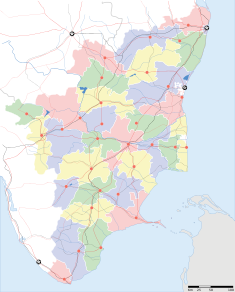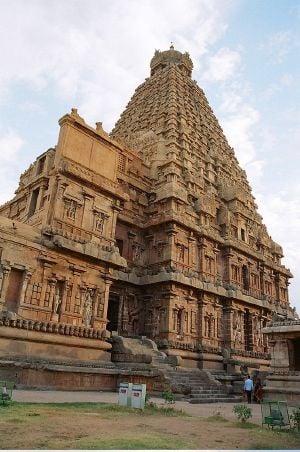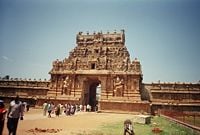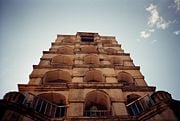Difference between revisions of "Great Living Chola Temples" - New World Encyclopedia
Dan Davies (talk | contribs) |
Dan Davies (talk | contribs) |
||
| Line 30: | Line 30: | ||
|architecture = [[South Indian]], [[Kovil]] | |architecture = [[South Indian]], [[Kovil]] | ||
|location = [[Thanjavur]] | |location = [[Thanjavur]] | ||
| − | }} | + | }}—> |
| − | —> | ||
The ([[Tamil language|Tamil]]: {{lang|ta|பெருவுடையார் கோவில்}}; '''Peruvudaiyar Koil'''<ref>{{cite web| title= Bragatheeswarar Temple, The Big Temple|url=http://www.thanjavur.com/bragathe.htm|publisher=thanjavur.com| accessdate=2007/09/29}}</ref><ref>Brihadeeswarar is also spelled ''Brihadeshvara'', ''Birhadeeshwara'' or ''Bragatheeswarar''</ref>) is an ancient [[Hinduism|Hindu]] temple located at [[Thanjavur]] in the state of [[Tamil Nadu]], [[India]]. The temple is dedicated to [[Shiva]] and dates to the [[Chola dynasty]] rule in the [[11th century]] [[Common Era|CE]]. | The ([[Tamil language|Tamil]]: {{lang|ta|பெருவுடையார் கோவில்}}; '''Peruvudaiyar Koil'''<ref>{{cite web| title= Bragatheeswarar Temple, The Big Temple|url=http://www.thanjavur.com/bragathe.htm|publisher=thanjavur.com| accessdate=2007/09/29}}</ref><ref>Brihadeeswarar is also spelled ''Brihadeshvara'', ''Birhadeeshwara'' or ''Bragatheeswarar''</ref>) is an ancient [[Hinduism|Hindu]] temple located at [[Thanjavur]] in the state of [[Tamil Nadu]], [[India]]. The temple is dedicated to [[Shiva]] and dates to the [[Chola dynasty]] rule in the [[11th century]] [[Common Era|CE]]. | ||
Revision as of 01:46, 13 December 2007
| Great Living Chola Temples* | |
|---|---|
| UNESCO World Heritage Site | |
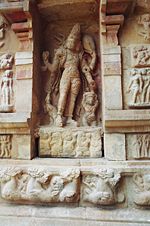
| |
| State Party | |
| Type | Cultural |
| Criteria | i, ii, iii, iv |
| Reference | 250 |
| Region** | Asia-Pacific |
| Inscription history | |
| Inscription | 1987 (11th Session) |
| Extensions | 2004 |
| * Name as inscribed on World Heritage List. ** Region as classified by UNESCO. | |
The Great Living Chola Temples are temples built during the Chola rule in the south of India. These temples are the Brihadisvara Temple at Thanjavur, the Temple of Gangaikondacholisvaram and the Airavatesvara Temple at Darasuram. The Brihadisvara Temple was declared by UNESCO as a World Heritage Site in 1987; the Temple of Gangaikondacholisvaram and the Airavatesvara Temple at Darasuram were added as extensions to the site in 2004. The site is now known as the "Great Living Chola Temples."
Brihadeeswarar Temple
The (Tamil: பெருவுடையார் கோவில்; Peruvudaiyar Koil[1][2]) is an ancient Hindu temple located at Thanjavur in the state of Tamil Nadu, India. The temple is dedicated to Shiva and dates to the Chola dynasty rule in the 11th century CE.
The temple is part of the UNESCO World Heritage Site "Great Living Chola Temples."
History
The temple was built by Chola king Rajaraja Chola I. Construction was completed in 1009-10 C.E.
Architecture
This temple is a prime example of the Dravidian style of temple architecture The central temple known as the Periya Kovil (Big Temple) stands within a fort, whose walls were later additions built during the 16th century. The name periya kovil came from its original name "periya aavudayar kovil" (aavudayar being a local name of Lord Shiva). The vimana (main tower) of the temple is approximately 65 m (215 ft) high and is the tallest in the world. It was so designed that the vimana never casts a shadow at noon during any period of the year.
More details on this temple can be found at http://www.templepages.com
Temple of Gangaikondacholisvara
- From Main article: Gangaikonda Cholapuram
The temple of Gangaikondacholisvara is approached through the northern entrance from the road. The passage passes through the enclosure wall and leads on to the inner court.
As one steps in, the great Vimana arrests the visitor's sight. The Vimana with its recessed corners and upward movement presents a striking contrast to the straight-sided pyramidal tower of Tanjavur. As it rises to a height of 160 feet and is shorter than the Tanjavur tower, it is often described as the feminine counterpart of the Tanjavur temple.
The Vimana is flanked on either side by small temples; the one in the north now housing the Goddess is fairly well preserved. The small shire of Chandikesvara is near the steps in the north. In the north-east are a shire housing Durga, a well called lion-well (simhakeni) with a lion figure guarding its steps and a late mandapa housing the office. Nandi is in the east facing the main shrine. In the same direction is the ruined gopura, the entrance tower. The main tower surrounded by little shrines truly presents the appearance of a great Chakravarti (emperor) surrounded by chieftains and vassals. The Gangaikondacholapuram Vimana is undoubtedly a devalaya chakravarti, an emperor among temples of South India.
| Thanjavur Tamil Nadu • India | |
| Coordinates: | |
| Time zone | IST (UTC+5:30) |
| Area • Elevation |
36 km² (14 sq mi) • 2 m (7 ft) |
| District(s) | Thanjavur |
| Population • Density |
215,725 (2001) • app. 7,700 /km² (Expression error: Unrecognized word "app". /sq mi) |
| Municipal Chairperson | Thenmozhi Jayabalan[3] |
| Codes • Pincode • Telephone • Vehicle |
• 613 001 till 009 • +914362 • TN 49 |
Coordinates:
- "Tanjore" redirects here.
Thanjavur
Thanjavur (Tamil : தஞ்சாவூர்), also known by its anglicised name Tanjore, is a city and a municipality in Thanjavur district in the Indian state of Tamil Nadu. Thanjavur is also the capital of the Thanjavur District. The city lies on the south bank of the Kaveri River. Thanjavur was the capital of the Mutharayars and Cholas when they were at the peak of their power. Since then, Thanjavur has been one of the chief political, cultural and religious centres of South India. Thanjavur is home to the famous Brihadeeswara Temple, one of UNESCO World Heritage Sites.
Thanjavur derives its name from Tanjan - an asura (demon) who according to local legend caused devastation and was killed by Sri Anandavalli Amman and Sri Neelamegapperumal. Tanjan's last request, that the city might be named after him, was granted.
History
The Thanjavur area, where a majority of Kallar and other families are presently located, has a rich historical heritage and is a prism of ancient as well as the modern south Indian civilizations. The city was once the stronghold of the historic Cholas.
Perumbidugu Mutharaiyar ruled his kingdom with Uraiyur as the capital[citation needed]. Later it was ruled by the Nayaks of Vijayanagara and the Maratha rajas.
Thanjavur contains over 90 temples, as it was favored by the Chola rulers between the 1st - 12th centuries, the Nayakas in the 16th century, and the Marathas in the 17th and 18th centuries.[4]
Under the Cholas
Thanjavur, or Tanjapuri as it was called in the ancient times was chosen by the Mutharayar king and later conquered by Vijayalaya Chola. Vijayalaya built a temple for his favourite goddess Nisumbhasudani in the city. Although subsequent emperors made Kanchipuram a subsidiary capital, Thanjavur maintained its position as the chief city. The great Brihadisvara Temple, built by Rajaraja Chola I was completed around 1010 C.E. It remained the centre of the Chola administration for many years, channelling the state revenue into a number of civic projects. It also acted as a repository of the empire's records, as the great Rajaraja had its walls covered with numerous inscriptions recording his conquests and his endowments to various charities. The impression we get from the inscriptions is of a wealthy, progressive city, although totally dominated by the temple.
The inscriptions tell us about a number of royal palaces in the city and of the districts where palace servants lived. We also learn the names of a number of streets: the big street of Virasola and the big market of Tribhuvanamadeviyar. During the reign of Rajaraja we learn that the city was divided into two parts: Ullalai (inner) and Purambadi (outer) city. Purambadi could have been an extension to the city built during Rajaraja's reign. Among the new streets built by Rajaraja were two running east to west in front of the Brihadisvara Temple and called Northern and Southern Talichcheries. People who worked in the temple occupied these streets. There were other temples then, such as the Jayabhima temple and Tanjai Mamani found in the inscriptions, which do not exist anymore. There was also a public hospital attached to a Vishnu temple named after Sundara Chola called Sundarachola Vinnagara Salai which was endowed by Kundavai, the sister of Rajaraja Chola.
The influence of Thanjavur began to diminish when Rajendra Chola I built a new city named Gangaikonda Cholapuram and moved his capital there.
After the Cholas
After the Cholas the Pandyas conquered the Chola country. Madurai was the Pandya capital and Thanjavur remained in the background, as a province of Vijaynagar empire.
Later in 1535,the Vijaynagar king installed a Nayak king hence the era of Tanjore Nayaks which lasted till mid-17th century, until attacked by the Madurai Nayaks. Later slipped into the hands of Marathas.
Tanjore was conquered by the Marathas in 1674 under Venkaji, the half-brother of Shivaji the Great; his successors ruled as rajas of Tanjore. The British first came into contact with Tanjore by their expedition in 1749 with a view to the restoration of a deposed raja of Tanjore Nayak lineage. In this they failed, and a subsequent expedition was bought off. The Maratha rajas held Tanjore until 1799. A Protestant mission at Tanjore was founded in 1778 by the Reverend Christian Friedrich Schwarz. His church dates from 1779.
In October 1799, the district was ceded to the British East India Company in absolute sovereignty by Raja Serfoji II, a pupil of the missionary Schwartz. The raja retained only the capital and a small tract of surrounding country. He died in 1833 and was succeeded by his son Sivaji, on whose death in 1855 without an heir the house became extinct.
Geography
Thanjavur is located at [5]. It has an average elevation of 2 metres (6 feet). The city lies on the south bank of the Kaveri River, 200 miles south of Chennai.
The city is primarily divided into two parts separated by a flyover. The Downtown [known as Old Town or simply Town] is the business district. The other side of the flyover is the residential area which is a relatively new neighborhood. The various neighborhoods are Palliagraharam, Karanthai, Old Town, Vilar, Nanjikottai Road, Manabuchavadi, Pookkara Street, New Town, Medical College, Old Housing Unit, New Housing Unit and Srinivasapuram.
The extension areas include Mariamman Koil, Gnanam Nagar, Kattuthottam, Nanjikottai, Madhakottai, Pillaiyarpatti, Nilagirivattam and Reddypalayam. The total population of the composite city touches 500,000 (unofficial figure). For all purposes the city extends from Vallam to Mariamman Koil (west - east) and Vayalur to Nanjikottai (north-south) for an area of 100 km².
Places of interest
Thanjavur is famous for the Brahadeeswara Temple (or Brihadeeswara temple) built by Rajaraja Chola, the first sailor king of India. The Brahadeeswara Temple, also known as the Big Temple, is one of UNESCO World Heritage Sites. The temple is enclosed in two courts, surmounted by a lofty tower and including the exquisitely decorated shrine of Subrahmanya. Among the other historic buildings is the Vijayanagar fort, which contains a palace that was expanded by the Maratha king Serfoji II with an armoury, a Bell Tower and the Saraswathi Mahal Library, which contains over 30,000 Indian and European manuscripts written on palm leaf and paper.
Arts and Culture
Thanjavur is one of the chief political, literary and religious centres of southern India, known for its contribution to Carnatic music, it has produced many classical musicians and Bharathanatyam dancers. It has become the second most important site for the annual Natyanjali dance festival.
Tiruvaiyaru, which is close to Thanjavur, is the place where the great musician Saint Tyagaraja lived. Here in Tiruvaiyaru every year in the tamil month of 'Thai'(January end) Thyagaraja Aradhana will be held where musicians from all over the country will participate.
It is also well known for its unique painting style called Tanjore Painting, a percussion instrument called the Thavil, a divine classical string instrument Veenai and the Thanjavur Dolls[6].
The Tanjore paintings are very popular and are renown around the world. The artists use a combination of canvas background with glass, metals, etc. to depict and decorate various scenes from Hindu mythology.
Tanjore plates which are made of color glass pieces which are aesthetically cut and embedded on velvet cloth. It will have god image or birds at the center.
Demographics
The city is the 8th largest in the state of Tamil Nadu with a census population of around 225,000 (est. 2005). It has an area of 36 km². Ethnically most of the people are Tamils. There is also a large Telugu population along with Saurashtrians and Thanjavur Marathi people. As of 2001 India census[7], Thanjavur had a population of 215,725. Males constitute 50% of the population and females 50%. Thanjavur has an average literacy rate of 80%, higher than the national average of 59.5%: male literacy is 85%, and female literacy is 76%. In Thanjavur, 9% of the population is under 6 years of age.
Here in Thanjavur in 1994, 8th Tamil world conference was held.
Nearby Towns
- Tiruchirappalli - 55 km West,
- Tiruvaiyaru - 15 km North West,
- Perambalur - 50 km North West,
- Kumbakonam - 40 km North East,
- Tiruvarur - 58 km East,
- Nagappattinam - 84 km East,
- Mannargudi- 37 km East,
- Thiruthuraipoondi - 66 km South East,
- Vailankanni - 96 km East,
- Pattukkottai - 40 km South East,
- Pudukkottai - 55 km South
Employment
Most of the people in Thanjavur District are farmers. Thanjavur is the rice bowl of TamilNadu. In the city of Thanjavur there are a large number of doctors due to the presence of a 50-year old medical college. The first M.B.B.S. doctor of this city was the late Dr. N. Ramanathan, who served as a general practitioner of medicine from 1938 to 1988. Even today, there is a bus stop with his name, near his hospital. Also there are a large number of professors working in the various professional and arts colleges around the city.
Education
Thanjavur is renowned for its culture of education. It is home to the famous Saraswati Mahal library which dates back to the end of the 16th century and contains over 30,000 rare manuscripts. It has now been fully computerized. St. Peter's, founded in the 18th century by Schwartz, is a renowned school. Currently, Thanjavur has two universities, viz., the Tamil University and the SASTRA Deemed University, and several colleges including the renowned Thanjavur Medical College. This city also has many research centres like the Paddy Processing Research Centre, Soil and Water Research Centre, etc.
Thanjavur has a high number of Software Engineering Professionals, Doctors, Engineers, Teachers etc.
List of Universities:
- Tamil University.
- Sastra University (Formerly Shanmugha College of Engineering. Sastra has a very well developed sprawling campus on a 500 acre site and is an accredited Research and Development Centre under the President's Technology Mission - TIFAC CORE. Sastra has collaborations and exchange Programs with many reputed Universities abroad.Sastra University
- Periyar Maniammai University
List of Autonomous colleges:
- A.V.V.M Sri Pushapam College(Autonomous) poondi, Thanjavur Dt.(A.Veeraiya Vandaiyar Memorial Sri Pushpam College was established in 1956 in a village Poondi, 12 km from Thanjavur on the way to Nagapattinam in Tamilnadu state in India on the National High Way 74. The College is having a campus of 85 acres, NAAC accreditation with status of four stars.
- Rajah Serfoji Govt. College
- Kundhavai Nachiar Govt. College
List of Colleges:
Medical and Paramedical
- Thanjavur Medical College.
- Mannai Narayanasamy College.
- Arasu Paramedical College.
- Konagarnadu College of Nursing.
Engineering
- P R Engineering College(PREC).
- Ponnaiyah Ramajayam College Of Engineering and Technology(PRCET).
- Periyar Maniyammai College of Technology for Women.
- Anjalaiammal Mahalingam Engineering College.
- King's College of Engineering (KCE).
Arts, Science and Management
- Rajah Serfoji Government Arts College, Thanjavur.
- Kundhavai Nachiar Government Arts College.
- Ponnaiah Ramajayam College(PRC).
- Tamilvel Umamaheshwaranar Karanthai Arts College.
- A.V.V.M Sri Pushpam College
- Na. Mu. Venkatasamy Nattar College.
- Nalli Kuppusamy College
- Bharath College of Science and Management.
- Marudhupandiar College.
- Madha Sami Arul College.
- Adaikala Matha College.
- Bon Secours College.
- Abi & Abi College of Arts and Science
- Adikalamatha Institute of Management.
- P. R. Institute of Managemnet.
Polytechnics
- Periyar Centenary Polytechnic.
- Ponnaiyah Ramajayam Polytechnic college
- Vandayar Polytechnic.
- CCMR Polytechnic.
Teacher Training Institutes
- Ponnaiyah Ramajayam Teacher Training Institute(PRTTI).
- Ponnaiyah Ramajayam College of Education(PRCE).
- Maruthu Pandiar College of Education
- Bon Secours College of Education
Famous Schools
- KalyanaSundaram Higher Secondary School (Established in 1893)
- Don Bosco matric hig.sec.shool
- Kamala subramaniam matric hig.sec.shool
- Ponnaiyah Ramajayam Public School
- Auxilium
- Sacred Heart
- Shri Venkateswara Matric Hig.sec.shool
- Veeraragava Higher Secondary School
- Umamaheswara Higher Secondary School
- St.Joseph
- St.Antonys Higher secondary school.
- St.Peters
- Maxwell Matric Hig.Sec.School
Top Government Officials
- Deputy Inspector General of Police.. Mr Abhash Kumar IPS
- District Collector.. Mr Vijayaraj Kumar IAS
- District Superintendent of Police Mr Amit Kumar Singh IPS
Popular personalities
- 'Dr.R.venkataraman'FORMER President of the Republic of India
- Thiru U.Ve.Swaminatha Iyer (Tamil Thatha), Tamil Scholar
- Actor Nadigar Thilagam Pathmashree Sivaji Ganesan
- Late Thiru G.K.Moopanar,Founder Tamil Maanila Congress.
- ThiruK.Thulasi ayya Vandayar,Secretary and corespondent of A.V.V,M SRI PUSHPAM COLLEGE
- Thiru Ko.Si.Mani, Tamil Nadu Minister for Statistics and Ex-Servicemen
- Thiru.S.S.Palanimanickam, Union Minister of State for Finance(Revenue)
- Dr.M.Natarajan,Managing Director of Tamilarasi Publication Pvt Ltd and Social Activist
- Prof. R.Sethuraman, Vice-Chancellor,SASTRA UNIVERSITY
- Thiru G.K.Vasan,Union Minister of State for Statistics & Prog Imp(Independent Charge).
- Thiru S.N.M.Ubayadulla, Tamil Nadu Minister for Commercial Taxes
- Thiru. Rt.Hon.Srinivasa sastri, Known as the SILVER TOUNGED for profeciency in English
- Thiru. Basel Pillar RAJAKUMAR A
- Dr.S.Jayakumar,Chief Technology Officer,Epigon Media Technologies
ReferencesISBN links support NWE through referral fees
- This article incorporates text from the Encyclopædia Britannica Eleventh Edition, a publication now in the public domain.
- ↑ Bragatheeswarar Temple, The Big Temple. thanjavur.com. Retrieved 2007/09/29.
- ↑ Brihadeeswarar is also spelled Brihadeshvara, Birhadeeshwara or Bragatheeswarar
- ↑ The Hindu dated 29 October 2006
- ↑ Brahadeshvara Temple. Retrieved 2006-09-14.
- ↑ Falling Rain Genomics, Inc - Thanjavur
- ↑ Thanjavur Dolls in Action (Animation)
- ↑ GRIndia
—>
Airateswara Temple
Airateswara Temple is a Hindu temple located in the town of Darasuram, near Kumbakonam in the South Indian state of Tamil Nadu. This temple, built by Rajaraja Chola II in the 12th century CE, along with the Brihadeeswara Temple at Thanjavur, the Gangaikondacholisvaram Temple at Gangaikonda Cholapuram are a UNESCO World Heritage Site referred to as the Great Living Chola Temples[1].
Legend
The Airateswara temple is dedicated to Lord Shiva. Shiva is here known as Airavateshwara, because he was worshipped at this temple by Airavata, the white elephant of the king of the gods, Indra.
It is said that the King of Death, Yama also worshipped Shiva here. Tradition has it Yama, who was suffering under a Rishi's curse from a burning sensation all over the body, was cured by the presiding deity Airavateswarar. Yama took bath in the sacred tank and got rid of the burning sensation. Since then the tank has been known as Yamateertham.
Architecture
This temple is a storehouse of art and architecture and has some exquisite stone carvings. Although this temple is much smaller than the Brihadeeswara Temple or the Gangaikondacholisvaram Temple, it is more exquisite in detail. This is because this temple is said to have been built with nitya-vinoda, "perpetual entertainment," in mind.
The vimana is 25 m (85 ft) high. The front mandapam is in the form of a huge chariot drawn by horses.
Darasuram is a small town near Kumbakonam in Tamil Nadu state in southern India. It is known for the Airavatesvara Temple built by Rajaraja Chola II in the 12th century CE.
This temple is a storehouse of art and architecture. The vimana is 85 feet high. The front mandapam itself is in the form of a huge chariot drawn by horses. The temple has some exquisite stone carvings. The main deity's consort Periya Nayaki Amman temple is situated adjacent to Airavateshwarar temple.
The Great Living Chola Temples. (a UNESCO World Heritage Site) at Thanjavur, Gangaikonda Cholapuram and Darasuram were built by the Cholas between the 10th and 12th centuries CE and have a lot of similarities.
The legend goes to show that Airavata, the white elephant of Indra, worshipped Lord Siva in this temple; so did also the King of Death, Yama. Tradition has it that the presiding deity Airavateswarar cured Yama himself (the God of Death) who was suffering under a Rishi's curse from a burning sensation all over the body. Yama took bath in the sacred tank and got rid of the burning sensation. Since then the tank is known as Yamateertham. It gets its supply of fresh water from the river Kaveri and is 228 feet in width. The pilgrims always make a point to have a bath in the tank. In the recent past Raja Raja Chola and Karikala Chola worshipped the Siva Lingam in this temple. Volume II of the South Indian Temple Inscriptions deals with a number of endowments of the Pandya Kings also (vide pages 556 to 562) On the temple walls these inscriptions are given, from which it is seen that the temple was known in those days as Raja Rajeswararn and Raja Rajapuram. Two such inscriptions are copied here.
Inscription No. 563 of the Book at page 557.No. 23 of 1908 on the inner Gopura of the temple, right of entrance. Record dated in the 10th Year, Tai 11, of the reign of the Pandya King Maravarman alias T ribhuvana Chakravartin Srivallabhadeva registering the provision made for repairs and for celebrating festivals in the temple of XXXI Ra (ja) ra (ja) isuram Udaiyanayanar, by the residents of Uttattur-nadu, a sub-division of Kulottunga-valanadu.
Inscription No. 564 at page 558. Record dated in the 31st Year, Makara, Ba. Dvitiya, Uttarashada (probably a mistake for Uttaraphalguna) of the reign of the Chola king Tribhuvana Ghakravartin Sri RAJARAJADEVA registering the grant of land (Irandu Ma mukkani araikkani) 23/160 of a veli to meet the expenses of worship, offerings, etc., to the God by a native of Peruchchalipuram, a village in Kilar-kurram, a sub-division of Pandyakulapati-valanadu.
As originally Airavata worshipped the Lingam, the Lingam is named after him as Airavateswara. The Goddess in this temple is known as Deva Nayaki. Whatever remains of the sculptural part of the temple is on the inside wall of the outer prakaram, about a foot from the floor level. 'The carvings contain different poses of gymnastic feats we see in modern circus, shown by females keeping their head at the centre and legs interwoven in such a skilful way as to form the circumference of a circle. It may be a depiction of the present-day gypsy tribe entertaining villagers with skilful gymnastic shows and dancing poses. Such gypsies are still to be seen visiting the interior villages of the country. Very many styles of physical feats shown by both men and "men have been carved a stone.
All the dancing poses of Bharatanatyam are carved a stone. There is a carving showing the village womenfolk helping in delivery of another female, who has put both her hands on the shoulders of the two ladies, who are pressing their hands and the abdomen of the lady to help her deliver. 'These are very skilful and artistic works of superb style. This may give a glimpse into the social conditions of the past. The stone image of Ravana carrying Kailas is a fine specimen of workmanship.
At the very entrance to the temple two Dwarapalakas, Sankhanidhi and Padmanidhi, are imposing figures, giving vivid anatomical expressions of the exuberance of youth. In front of the temple, there is a small mandapa, which can be reached by 3 steps in the form of a ladder. The steps are made of stones, which give different musical sounds when tapped All the seven swaras can be had at different points. If proper care is not taken the village children will spoil the stones soon.
Deities
The main deity's consort Periya Nayaki Amman temple is situated adjacent to Airavateshwarar temple.
UNESCO World Heritage Site
This temple was added to the list of Great Living Chola Temples in the year 2004. The Great Living Chola Temples includes the Brihadeeswara Temple at Thanjavur, the Gangaikondacholisvaram Temple at Gangaikonda Cholapuram and the Airateswara Temple at Darasuram. All of these temples were built by the Cholas between the 10th and 12th centuries CE and have a lot of similarities.
The Airavateshwarar temple
The Brihadeeswarar Temple
See also
References
External links
- UNESCO's World Heritage Site.
- Panoramic 360 degree views of the Temple.
- TLC: Mysteries of India: Lost South Indian Temples (via Google Video).
- Photographs of Brehadiswara and other South Indian Temples.
- Article on Indian Murals.
- Brihdeeswara Temple Guide.
- Brihadeeswarar Temple.
- Photos of Thanjavur Periya Kovil.
- UNESCO's World Heritage Site: listing the Chola temples.
- Photo gallery, details about this temple
| |||||||
| |||||||
Credits
New World Encyclopedia writers and editors rewrote and completed the Wikipedia article in accordance with New World Encyclopedia standards. This article abides by terms of the Creative Commons CC-by-sa 3.0 License (CC-by-sa), which may be used and disseminated with proper attribution. Credit is due under the terms of this license that can reference both the New World Encyclopedia contributors and the selfless volunteer contributors of the Wikimedia Foundation. To cite this article click here for a list of acceptable citing formats.The history of earlier contributions by wikipedians is accessible to researchers here:
The history of this article since it was imported to New World Encyclopedia:
Note: Some restrictions may apply to use of individual images which are separately licensed.


